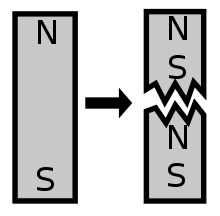
In particle physics, a magnetic monopole is a hypothetical elementary particle that is an isolated magnet with only one magnetic pole (a north pole without a south pole or vice versa).[1][2] A magnetic monopole would have a net north or south "magnetic charge". Modern interest in the concept stems from particle theories, notably the grand unified and superstring theories, which predict their existence.[3][4][full citation needed] The known elementary particles that have electric charge are electric monopoles.
Magnetism in bar magnets and electromagnets is not caused by magnetic monopoles, and indeed, there is no known experimental or observational evidence that magnetic monopoles exist.
Some condensed matter systems contain effective (non-isolated) magnetic monopole quasi-particles,[5] or contain phenomena that are mathematically analogous to magnetic monopoles.[6]
- ^ Hooper, Dan (October 6, 2009). Dark Cosmos: In Search of Our Universe's Missing Mass and Energy. Harper Collins. ISBN 9780061976865 – via Google Books.
- ^ "Particle Data Group summary of magnetic monopole search" (PDF). lbl.gov.
- ^ Wen, Xiao-Gang; Witten, Edward, "Electric and magnetic charges in superstring models", Nuclear Physics B, Volume 261, pp. 651–677
- ^ S. Coleman, "The Magnetic Monopole 50 years Later", reprinted in Aspects of Symmetry
- ^ Cite error: The named reference
Castelnovowas invoked but never defined (see the help page). - ^ Ray, M. W.; Ruokokoski, E.; Kandel, S.; Möttönen, M.; Hall, D. S. (2014). "Observation of Dirac monopoles in a synthetic magnetic field". Nature. 505 (7485): 657–660. arXiv:1408.3133. Bibcode:2014Natur.505..657R. doi:10.1038/nature12954. ISSN 0028-0836. PMID 24476889. S2CID 918213.